A Roadmap for Collaboration
By Jennifer L. Turner, Karen Mancl & Jennifer Nguyen
January 2024

CULTIVATING US AND CHINESE CLIMATE LEADERSHIP ON FOOD AND AGRICULTURE
The Woodrow Wilson International Center for Scholars was chartered by the US Congress in 1968 as the living memorial to the nation’s twenty-eighth president. It serves as the country’s key nonpartisan policy forum, tackling global challenges through independent research and open dialogue. Bridging the worlds of academia and public policy, the Center’s diverse programmatic activity informs actionable ideas for Congress, the administration, and the broader policy community. Please visit us online at www.wilsoncenter.org
Opinions expressed in Wilson Center publications and events are those of the authors and speakers and do not represent the views of the Wilson Center.
Since 1997, the Woodrow Wilson Center’s China Environment Forum (CEF) has carried out research and exchange projects that bring together American, Chinese, and other Asian experts to explore the most imperative environmental and sustainable development issues both inside China and in the greater Asian region. The networks built and knowledge gathered through meetings, publications, and research activities have established CEF as one of the most reliable sources for information on China/Asian environment trends. Over 26 years, CEF has undertaken long-term and specialized projects on topics such as clean energy development in the United States and China, water-energy confrontations, environmental justice, Japan-China-US clean water networks, water conflict resolution, food safety, and environmental activism and green journalism in China.
Our current initiatives:
• The Plastic Pipeline: A Serious Game for Plastic Reduction Education is an educational video game project created in partnership with the Wilson Center’s Serious Games Initiative that aims to bring the complex world of plastic policy to the fingertips of people around the world and to spread knowledge about the sources of and solutions to plastic waste leakage.
• Vulnerable Deltas is a research and convening project in partnership with the East-West Center exploring the climate, pollution, and development threats to three deltas in Southeast Asia (Mahakam, Chao Phraya, and Mekong) and two in China (Pearl and Yangtze).
This publication is produced under the Wilson Center and Ohio State University joint project: Cultivating US and Chinese Climate Leadership on Food and Agriculture, supported in part by the US Embassy in Beijing. The project was launched in September 2022, and today we succinctly call it the Cool Agriculture Project. While the United States and China are starting to decarbonize food production, it is not yet an area of significant bilateral collaboration or dialogue. Over the past year, we have engaged with US and Chinese agriculture, food system, and climate experts with two goals in mind to: (1) illustrate the complex climate footprint from US and Chinese agriculture and (2) highlight opportunities for bilateral cooperation on policies, projects, and strategies to reduce agriculture’s climate footprint. The meeting videos, blogs, and podcasts we have produced are available on the Wilson Center’s website at: Cool Agriculture: Climate and Food Challenges in the US and China

CULTIVATING US AND CHINESE CLIMATE LEADERSHIP ON FOOD AND AGRICULTURE
A Roadmap for Collaboration
By Jennifer L. Turner, Karen Mancl & Jennifer Nguyen
January 2024
ACKNOWLEDGEMENTS
This publication would not have been possible without the assistance of our project partners. We drew considerable insights for this publication from the six Cool Agriculture podcasts Sustainable Asia produced for us. We also learned from the great research and writings on food and climate from the Institute for Global Decarbonization Progress (iGDP) and the Global Environmental Institute (GEI). China Dialogue produced three wonderful multimedia stories for the Wilson Center’s New Security Beat blog on how US and Chinese farmers are coping with climate challenges, reminding us that it is the farmers who are on the frontlines of this crisis and key players in the solution.
We also are indebted to our advisory committee who gave us invaluable guidance on agrifood issues to focus on in our public meetings, publications and podcasts. They also were a great tough love crew in reviewing this publication. Any and all omissions and errors of course remain those of the authors.
Lastly, we salute the CEF research interns who gathered mountains of data for this report and generated rough drafts of the infographics. Our talented graphic designers Kerrin Cuison and Kathy Butterfield transformed those drafts into beautiful and sometimes humorous (burping cows and smiling rice bowls!) infographics to help us tell the agrifood-climate science and stories. Their creativity is unrivaled. We also want to give a shout out to Marty Zhu for his speedy work translating this report into Chinese—even conquering our corny food puns!
Authors
Dr. Jennifer L. Turner has been the Director of the Wilson Center’s China Environment Forum for 24 years. She has led in the creation of climate, energy, and other environmental programming. She was the producer of Choke Point: China, the CEF-Circle of Blue multimedia reporting project 2010-2018. The Choke Point: China reporting helped inform the creation of the Water-Energy Technology Program under the 2014 US-China bilateral climate agreement.
Dr. Karen Mancl is a Professor of Food, Agricultural and Biological Engineering and Water Quality at the Ohio State University where she has published over 50 journal articles and 80 extension publications on rural infrastructure and outreach initiatives. She is currently a 2023-24 Wilson Center Policy Scholar pursuing a research project entitled Planting the Seed for Renewed Agricultural Collaboration Between the United States and China
Ms. Jennifer Nguyen is the Program Coordinator for the China Environment Forum and is the managing editor for the China Environment Forum’s column on New Security Beat
Managing Editor: Jennifer Nguyen
Assistant Editors and Infographic Researchers: Danning Lu, Yiming Zhong, and Zhiyuan Zhou
Final Copy Editor: Richard Byrne
Chinese Translator: Marty Zhou
Research Assistants: Yunyi Huang, Josie Liu, and Ann Williams
Graphic Designers: Kathy Butterfield and Kerrin Cuison
Advisory Committee
Larry M. Antosch, Ohio Farm Bureau Federation
Fan Dai, California-China Climate Initiative
Kevin Chen, International Food Policy Institute
Min Fan, US Heartland China Association
Patty Fong, Global Alliance for the Future of Food André Vasconcelos, Global Canopy
Image sources: Shutterstock.com
Timeline on US-China Climate Cooperation 6-9 SECTION 1: US-CHINA FOOD SUPERPOWERS AND THE GLOBAL CLIMATE FOOTPRINT OF FOOD 10 Infographic: Interlinked and Interconnected Food: US-China Agricultural Trade 11 Infographic: The United States and China as Food Superpowers .................................................. 12 Box 1.: Why the Climate Change-Agrifood Nexus Matters 13 SECTION 2: THREE PROMISING AREAS FOR US-CHINA AGRIFOOD AND CLIMATE COLLABORATION 14 Infographic: Soil is a Bank Account 14 Soil: The Silent Climate Fighter 15 Infographic: Bankrupting the Health and Carbon of our Soil .......................................................... 16 Infographic: Soil Health and Carbon Sequestration Action 17 Infographic: The Climate Price of Rice 18 Rice: A Sticky Climate Challenge ................................................................................................. 19 Food Waste: A Low-Hanging Fruit for Methane Reduction 20 Infographic: From Farm to Fork to Landfill 21 Infographic: US and Chinese Food Waste Policies and Programs 23 SECTION 3: A CORNUCOPIA OF UNTAPPED AREAS FOR US-CHINA FOOD AND CLIMATE COOPERATION 24 Agricultural Methane: Moooving into Cows and Other Livestock Emissions 24 Infographic: The Methane Hoofprint of Cows ................................................................................ 25 Box 2.: Areas Ripe for Bilateral Science and Policy Dialogues 26
TABLE OF CONTENTS
Timeline for US-China Climate, Clean Energy, and Agricultural Cooperation
1979
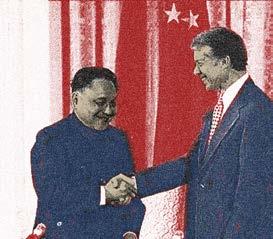
• Scientific and Technology Cooperative Agreement
• Atmosphere and Science and Technology Protocol
• MOU for 19 Bilateral Energy Agreements
• US-China Agricultural Exchanges start
1985
• Fossil Energy Protocol (Renewed in 2000 and 2005)
• Xi visits US as part of agricultural exchange
1997
• 1st Meeting of US-China Forum on Environment & Development
1999

2000
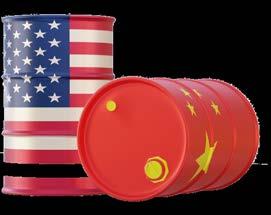
• US-China Advanced Biofuels Forum
1995
• Energy Efficiency and Renewable Energy Protocol
• 2nd Meeting of US-China Forum on Environment & Development
• US-China Bilateral Agreement on WTO (agriculture included)
• Agreement on US-China Agricultural Cooperation

1994
• Annexes to the Fossil Energy Protocol
2006

• First Meeting of the US-China Strategic Economic Dialogue (2nd Meeting 2009)
2007 2008
• USDA and NDRC Sign MOU Biofuels
• Ten Year Energy & Environment Cooperation Framework
• US-China Race to Zero Emissions Challenge
• Second US-China Joint Announcement on Climate Change
2016 2017 STOP
• US withdrawal from Paris Climate Agreement
• Xi calls for a halt in US-China science and technology exchanges
2015
• COP21 Climate Negotiations Dig Into Soil Sequestration–4 per 1000 Initiative
• Paris Climate Agreement
• US-China Green Ports and Vessels Initiative
• US-China Clean Energy Research Centers Expand
2014
• Climate-Smart / Low-Carbon Cities Initiative launched
• First US-China Joint Announcement on Climate Change
2013
• Presidents Obama and Xi Agree to phase down HFCs under the Montreal Protocol
• US-China Climate Change Working Group Launched
2012
• Framework Plan for Ocean and Fishery Science and Technology Cooperation
• Obama-Hu 9 New Clean Energy Agreements
• US-China Clean Energy Research Centers launched
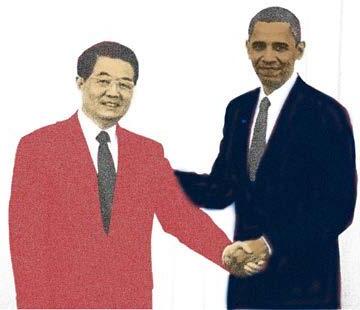
• US – China Cooperation on Climate Change, Clean Energy, and the Environment Statement
• US-China Agreement on Cooperation In Science and Technology Extended
2009 2010
2011
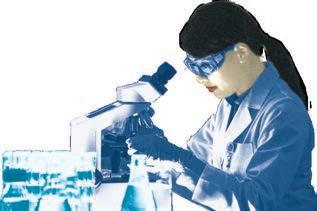
• US-China Advanced Biofuels Forum
• US-China Energy Efficiency and Renewables Forums
2018
• US-China Trade War

20182019
• Silence in the bilateral climate relations......
• US rejoins Paris Climate Agreement
• President Biden announces US and China must cooperate on climate change at G20
• China halts climate talks after Speaker Pelosi’s visit to Taiwan
• US ratifies Kigali Amendment to the Montreal Protocol
2022
2021
2023
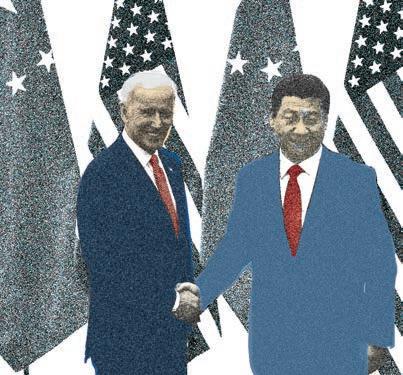
• US-China Sunnylands Statement on Enhancing Cooperation to Address the Climate Crisis
• US-China relations worsened during COVID-19

• Global Methane Pledge launched at COP26
• US-China Glasgow Declaration at COP26
• China ratifies Kigali Amendment to phase down HFCs under Montreal Protocol
• Joint US-China statement on Climate mentions agriculture
2020
• At COP28 in Dubai, the US and China joined 150+ countries in signing the Declaration on Sustainable Agriculture, Resilient Food Systems and Climate Action
2024 & Beyond?
Potential Path for US-China Climate Cooperation
US-China Climate Cooperation
Prioritized in the Sunnylands Statement
Set up a Working Group on Enhancing Climate Action in the 2020s
Restart the US-China Energy Efficiency Forum
Create a Technical Working Group on Methane
Recommence bilateral dialogues on energy policies and strategies
Phase down HFCs and manage nitrous oxide emissions
Hold a high-level event on subnational climate action
Advance 5 carbon capture and use sequestration projects in each country by 2030
Implement the 2021 US-China Joint Statement and US-China Glasgow Declaration goals, which includes climate action on agriculture
US-CHINA FOOD SUPERPOWERS AND THE GLOBAL CLIMATE FOOTPRINT OF FOOD 1
Coal and cars have long been the most prominent concerns for climate advocates. Yet experts are now raising the urgency of also lowering food’s greenhouse gas (GHG) footprint—both to slow the climate crisis and to ensure global food security.
The agrifood sector—from production and processing to transport and disposal—accounts for 31% of global GHG emissions. Methane from livestock (cow burps and manure) and rice are major GHG emitters in food production. Nearly a quarter of agrifood emissions come from soil carbon released when land is converted to cropland. The increased use of fossil fuel-based fertilizers and plastic packaging along with the expansion of globalized food supply chains are also driving agrifood GHG emissions. As the world’s food production and consumption superpowers, the United States and China are major contributors to agrifood GHGs.
With a population of 1.4 billion, food security concerns have long driven China’s agricultural policy. For the past 20 years China has been gradually losing the ability to be food independent. China’s food security index was 93.6% in 2000, meaning the country grew enough food to feed most of its population. In 2020, that number had fallen to 65.8%. This shift is driven in part by the changing diets of China’s growing, increasingly urban, middle class. Food safety concerns have also increased consumer demand for some food imports.
To fill the food security gap, China became the world’s leading agricultural importer with the United States as its biggest supplier of soybeans and grains. China is also increasingly dependent on US meat and animal exports This interlinked trade has defined the bilateral agricultural relationship. (See Interlinked Trade Infographic).
The food system is now the second largest source of GHGs in the United States, accounting for 9 to 11% of
total domestic emissions. In China, farming and animal husbandry contribute 8.2% of the country’s total GHG emissions, with over 50% stemming from agricultural methane and nitrous oxide.
Extreme weather driven by climate change is also threatening food security around the world. But climate-smart agricultural practices can help combat the climate crisis and meet the food demands of a growing global population.
Zeroing in on climate action surrounding food production and consumption can help the United States and China reach their net zero goals. Encouragingly, both countries are starting to take steps independently to decarbonize food production.
The Biden administration has recognized this in massive funding for climate-smart agriculture to support farmers and offer incentives to adopt conservation agriculture and other practices. To reach China’s 2030 peak carbon and 2060 carbon neutrality goals, the Xi Jinping administration is starting to focus on agrifood emissions, emphasizing emission reductions from fertilizer use and agricultural waste. Chinese policymakers are also exploring policies to create incentives for improving soil quality to sequester carbon—and to measure progress towards that goal.
An Opening for US-China Agrifood Climate Action
Climate collaboration has been a near-constant feature in US-China diplomacy for 40+ years. The climate cooperation that grew over the past decades has centered on coal, the clean energy sector, vehicles, and buildings—but not agriculture. (See Timeline). Agricultural collaboration has been on a parallel track. Strikingly, agriculture was the first area of scientific exchange
10
between the two countries, beginning even before they signed the Science and Technology Agreement in 1979. Agricultural exchanges and joint projects on food security, animal health, agricultural technology, and biofuels have quietly strengthened the foundation of Sino-American relations over the decades. (See Food Superpowers Infographic).
It was not until 2021 that the diplomatic door for US-China agriculture and climate cooperation opened.
The April 2021 US-China Climate Crisis Statement and the US-China Glasgow Declaration both highlighted “green and climate resilient agriculture” as an area for joint work.
INTERLINKED AND INTERCONNECTED FOOD
US-China Agricultural Trade
China is the largest foreign market for US food and agricultural products
Despite trade war, US –China agricultural trade is on the rise again
What does America Buy From China ?
What does China Buy From the US?
*The percentages represent the monetary value of agricultural commodities each country imports from the other. For example, soybeans are 43.7% of the total value of Chinese agricultural imports from the United States.
Sources: AgEcon Search, FERN, Minnesota Department of Agriculture, Reuters, Statista, USDA, World Bank. Research by Zhiyuan Zhou and graphic design by Kerrin Cuison.
0 10 20 30 40 50 UNIT: BILLION DOLLARS 2022 2020 2016 2014
Chinese exports to the United States US exports to China 2018
3% Spices 3% Tea 2% Essential Oils 2% Planting Seeds 2% Animal Feeds 36% Fruits & Vegetables 43% Other (including nursery plants) 5% Snacks 1% Coffee 2% Tree Nuts of all US agricultural exports in 2022 19% worth of exports in 2022 $41bn increase from 2010 to 2022 3x 23.2% Other (including fish, poultry, and tree nuts) 4.5% Grains 43.7% Soybeans 3.3% Pork 12.9% Corn 5.6% Beef 7.1% Cotton
11
The US and China are Food Superpowers
China's growing appetite means greater potential for US-China food businesses and joint climate action









China has to feed 4x more people than the US on less land
After the Glasgow climate talks, the United States and China planned meetings to flesh out the details in the declaration. However, the climate dialogues were halted in 2022 in the midst of skyrocketing political tensions over Taiwan, espionage accusations, and broader geopolitical competition. Another challenge facing the relaunch of climate cooperation is the growing US concern over China’s dominance in the mining and refining of the critical minerals necessary for renewable energy and battery technologies that will make the clean energy transition possible.
Climate envoys John Kerry and Xie Zhenhua met in November 2023 and the two countries issued the Sunnylands Statement on Enhancing Cooperation to Address the Climate Crisis. The two sides committed to talks in 2024 and are notably prioritizing methane emissions and subnational climate cooperation. This renewed climate détente was timely. Food was on the climate negotiation table at COP28 where the
United States and China joined 157 countries signing the Declaration on Sustainable Agriculture and Resilient Food systems. It commits countries to integrate food into their climate action plans.
A Path Forward
Most scientific research between US and Chinese agricultural and climate scientists was frozen after the Trump administration withdrew from the Paris Climate Agreement and halted all climate and environmental dialogues with China. In our Cool Agriculture research and convenings over the past year, we uncovered some quiet US-China climate research projects on perennial rice, biofuels, and EV tractors. The two countries could greatly expand and elevate climate action in the agrifood sector.
This report outlines some of the possible paths forward, especially in three areas of agriculture: soil sequestration, reining in GHG emissions from rice,
of average farm size 444acres of the world's population 4% years of agriculture 200300 3.4million farmers of average farm size 1.6acres of the world's population 18% 957m2 cropland per capita 4,865m2 cropland per capita years of agriculture 30004000 177 million farmers
CHINA PRODUCES: of the world’s rice 29% of the world’s corn 22% of the world’s wheat 18% THE US PRODUCES: of the world’s corn 32% of the world’s soybeans 30% of the world’s beef 22%
Sources: AgEcon Search, AgWeb, FERN, Minnesota Department of Agriculture, Reuters, Statista, USDA, World Bank, Worldometer. Research by Zhiyuan Zhou and Karen Mancl and graphic design by Kerrin Cuison.
12
and reducing food waste methane. These pathways forward on agrifood and climate collaboration offer big mitigation potential and do not trigger politically sensitive tripwires.
This report is meant to be a catalyst for new conversations as the two countries restart climate meetings.
The 2014 US-China Climate Agreement helped pave the way for the Paris Climate Agreement. Similarly, action by these two food superpowers to address agrifood GHG emissions could help set the world on a path to climate-smart food production.
Why the Climate Change-Agrifood Nexus Matters
Climate Change Threats to Agriculture and Food Security
Extreme weather events reduce crop yields
Changing weather patterns shift planting and harvest time
Range of invasive species expands
Seasonality shifts hurt pollinators and animal breeding
Shifting cold hardiness zones require new kinds of crops
Agricultural Practices that Generate Greenhouse Gas (GHG) Emissions
Land use change (clearing forests for livestock or crops) is 18%+ of global food GHG emissions
Livestock emits 66% of global agricultural methane
Food loss and waste are responsible for 8-10% of global methane emissions
Rice emits 11% of global agricultural nitrous oxide emissions
Full lifecycle of fertilizers produces 5% of the global GHG emissions
Fossil fuels for farm equipment, grain drying, and irrigation were 2% of global GHG emissions in 2020
Agricultural Practices to Sequester Carbon / Reduce GHG Emissions
No-till and retaining crop residue C arbon credits and emission trading markets
C over crops Crops integrated with trees and livestock
P erennial crops A groforestry
Organic fertilizer Integrated soil fertility
Sources: Our World in Data, WRI, WWF, Greenhouse Gases: Science and Technology, University of Cambridge News, Environmental Research Letters
13
The Two-Step Carbon Deposit
First , plants absorb carbon dioxide from the air during photosynthesis (~30% of what humans emit every year)
Second, bacteria and fungi break down carbon-based plants and animals and store that carbon in the soil

Soil is the largest reservoir of carbon, 3x the amount stored in living plants


Conservation Agriculture Practices to Fill the Soil Carbon Account
• No-till
• Cover crops & crop rotation
• Integrating crops with livestock and trees
• Managed grazing

Soil Impoverishing Agricultural Practices
Tilling, monocrops, removing crop residue, overgrazing and excessive fertilizers release soil carbon BACK into the atmosphere

BANK
CO2
CO2 CO2 CO2
CO2
Sources: Climate Central, Columbia University, Nature, Science Direct, World Bank. Research and concept by Ann Williams and Jennifer Turner and graphic design by Kerrin Cuison.
14
CO2 CO2 Soil is a Carbon Bank Account THREE PROMISING AREAS FOR US-CHINA AGRIFOOD AND CLIMATE COLLABORATION 2
Soil: The Silent Climate Fighter
In the 1930s, overfarming, over-tilling, and overgrazing soil in the Great Plains of the United States resulted in the infamous Dust Bowl, which decimated 100 million acres and forced 400,000 people to flee their farms. In response to this catastrophe, officials and farm experts launched conservation agricultural practices to rebuild soil health and lessen dust storms. Today about 30% of US farms have adopted no-till and other healthy soil practices.
Yet catastrophic dust storms continue to impact the water-rich Corn Belt. Drivers in central Illinois had near-zero visibility when 55-mph winds blew dust from newly tilled fields in May 2023, causing a 90-car pileup. Four top soil scientists explained in an op-ed that over-tillage on two to three crops per year had eroded and degraded soil by reducing organic matter and carbon.
China can tell a similar story. Chinese scientists estimate current farming practices could completely erode the black soil in Heilongjiang Province (known as the granary of China) in 113 years. One Heilongjiang farmer lamented how much of his soil is washed away with heavy summer rains If China’s soil erosion continues at the current rate, an area as large as Puerto Rico will disappear in 50 years, resulting in a 40% drop in food production
Healthy Soil Healthy Climate
Soil is the foundation of food production and nature’s perfect creation to act as a medium for seeds to sprout and grow. Healthy soil has the ideal balance of minerals, organic matter, and air, allowing for the movement of water and the penetration of roots.
Soil is an oft-overlooked carbon sink. Soil conservation practices are critical climate actions that bolster both soil health and food security. Indeed, the COP 21 global climate talks—held in 2015—was the first to include soil in a climate proposal, the “4 per 1000” initiative
This proposal encourages voluntary adoption of conservation agricultural practices to increase the amount of carbon stored in the surface layer of soil by 0.4% per year (that is 4 parts per 1000). Merely hitting this target could offset 10% of annual global anthropogenic emissions. Meanwhile, in China, the 4 per 1000 approach could offset 25% of the country’s annual fossil fuel emissions.
As the Soil is a Bank Account infographic shows, conservation agricultural practices restore soil and ecosystem health through reduced soil erosion and compaction, enhanced soil fertility, water quality protection, and improved wildlife habitats. Farmers also benefit from reduced labor and fuel costs with the elimination of plowing.
Incentivizing Conservation Agriculture for Soil and Climate Health
The combination of aggressive tilling, poor farming techniques, and drought have catalyzed catastrophic erosion in the United States and China, spurring both into action. US and Chinese scientists and policymakers are promoting conservation agriculture as beneficial for both soil health and climate change mitigation. This shared goal creates an area for both countries to dig into together.
United States: After the 1930s, the government’s conservation agriculture push faced the challenge of convincing farmers to give up tilling the soil. The US Congress thus created the USDA Soil Conservation Service to support extension educators from Land Grant Universities to promote conservation agriculture at state and county levels. Starting in 1996, the Farm Bill created the EQiP program with incentives for adopting conservation tillage practices and planting cover crops.
In the early 2000s, the USDA went a step further. It established GRACEnet (Greenhouse Gas Reduction through Agricultural Carbon Enhancement Network)
15
to monitor GHG emissions under traditional management practices and to identify improved management processes. The USDA went on to develop COMETFarm, an online carbon emission accounting tool for farms and ranches.
Since 2022, the USDA Climate-Smart Agriculture Partnership grant program has supported farming and policy practices that increase soil health. Many environmental groups—such as The Nature Conservancy and the Environmental Defense Fund—have also worked with farmers to incentivize no-till and other climate-smart soil practices.
China: Low crop yields resulting from degraded soils and water shortages sparked the introduction of conservation agriculture in China in the 1990s. The immediate challenge posed by this change was the lack of no-till planting equipment capable of cutting through crop residue left on the soil surface. Since that time, Chinese agricultural universities and research academies have been developing appropriate machinery, as well as setting up long-term demonstration

sites. The government has supplied some farmers with this newly developed no-till planting equipment.
The Action Plan for Conservation Agriculture of Black Soil in Northeast China (2020 – 2025) promotes climate-smart practices in a major Chinese grainbelt. In 2022, China’s Ministry of Agriculture and Rural Affairs also issued an Implementation Plan for Emission Reduction and Carbon Sequestration in Agriculture and Rural Areas. In this plan, one of the ten major action areas included improving carbon sinks in farmland. These plans could promote the greater adoption of conservation agriculture, which currently is practiced on less than 5% of Chinese farmland.
In northern China, excessive irrigation and over-fertilization are being tackled with “fertigation,” a drip irrigation system that precisely delivers fertilizer and water to each plant. While often used in the United States for high-value fruit and vegetable crops, China is expanding this system to grains and field crops to conserve water and lessen fertilizer use. A co-benefit of this practice is lower GHG emissions.
Bankrupting Our Soil’s Health and Carbon
Degraded Land
Erosion, organic matter decline, biodiversity loss, compaction, heavy metal pollution, and salination have degraded 60% of arable land in the US and 58% in China

More than of China's arable land is becoming desert due to drought, inappropriate farming practices, overgrazing, and climate change


D POLLUTION

Disappearing Farmland
The US lost 12.5 million hectares of farmland (the size of Mississippi) to development between 1992 and 2013
Between 2001 and 2013, China’s rapid urbanization consumed 33 million hectares of agricultural land (about three Mississippis)
1/4
Environment,
PNA, HUD Exchange, the Guardian,
Concerned Scientists
Sources: American Farmland Trust US Congress, The White House, World Bank, ScienceDirect, Reuters, Farmland Info Center, Wilson Center, Chinese State Council, Chinese Ministry of Ecology and
China Daily,
Union of
Total Farmland (in million hectares) China 135 US 166 16
Soil Health and Carbon Sequestration
UNITED STATES
The Healthy Soils Healthy Climate Act (Proposed in 2023): Create a soil health program to fund farmers who adopt practices that increase soil carbon levels
Partnerships for Climate-Smart Commodities (2022): USDA investing $3.1 billion for pilot projects that sequester carbon or lower GHG emissions.
Growing Climate Solutions Act (2021): Incentivize farmers, ranchers, and forest landowners to join voluntary carbon markets
Farmland Protection Policy Act (1981): Minimize federal construction project impacts and irreversible conversion of farmland to nonagricultural use
Soil Conservation Act (1935): Created Soil Conservation Service to demo projects and practices to reduce soil erosion (renamed Natural Resources Conservation Service in 1994)



Healthy Deposits Into Our Soil Accounts
CHINA
Implementation Plan for Emission Reduction and Carbon Sequestration in Agriculture and Rural Areas (2022)
The Black Soil Protection Law (2022): Protect black land resources and ensure national food security
Soil Pollution Prevention and Control Law (2019): First comprehensive soil pollution law, creating new obligations and potential liabilities for land use holders
Soil Pollution Action Plan (2016): Aim to make 90% of polluted farmland soil safe for human use by 2020 and 95% by 2030
Dynamic Balance of Total Farmland Area Policy (1998): Ban conversion of high-quality cultivated land to non-agricultural use

gies necessary to monitor and incentivize these soil and carbon-friendly agricultural practices. Together, the two countries can also tackle the challenges of carbon measurement, monitoring, and verification in soil conservation practices. (These are tricky to measure because of the variability among land types and farming practices.)
Thus far, neither country has a common platform to make soil carbon data accessible for analysis. Filling these data and monitoring gaps is critical for esti -
Both countries have been piloting projects on carbon credits for soil conservation to encourage the adoption of conservation agriculture. The California Emissions Trading System and a number of voluntary carbon credit markets have been spreading around the United States, which offer lessons for the voluntary emission trading scheme China launched in the summer of 2023.
17
The Climate Price of Rice
Climate super pollutants, like methane and nitrous oxide, heat the earth faster than carbon dioxide
Compared to 80X METHANE CO2
300X NITROUS OXIDE
Rice feeds half the world's population daily
Climate-Smart Actions for Rice and Other Crops
USDA invested $300M as part of the In ation Reduction Act to improve measurement and reporting of agricultural emissions
To save water and emit less methane and nitrous oxide, China piloting practice to cover newly planted rice elds with plastic lms
12% of global methane emissions are from rice production
11%
Globally, rice elds generate of agricultural nitrous oxide emissions
Sticky Climate Challenge
Efforts to reduce methane almost always lead to greater nitrous oxide emissions
but is a major greenhouse gas emitter
Rice production is also water intensive
New Innovations and Solutions
Alternate wetting and drying, plastic mulch, and integrated aquaculture
New varieties of rice with higher yields and lower methane
4000 to 5000
liters of water are consumed per kilo of rice produced
The amount of unaccounted-for nitrous oxide global emissions from rice may be as high as the annual GHG emissions from 200 coal power plants
No-till agriculture and integrated nitrogen management
1/3 US
of the world's rice is produced by CHINA
2%
Sources: Associated Press, USDA ERS, China Dialogue, Karen Mancl, V Vinod Goud, IRRI, Josh Gabbatiss, Ei Phyu Win and Kyaw Kyaw Win, Sonoko D. Belilngrath-Kimura, Aung Zaw Oo, Mohammad Saiful Alam, Mariam Khanam, Md. Mizanur Rahman, WWF. Research and concept by Jennifer Nguyen and graphic design by Kerrin Cuison.
N2O N2O N2O N2O N2O N2O N2O N2O N2O
CH4
18
Rice: A Sticky Climate Challenge
Rice feeds half the world. Yet this major staple crop requires a lot of water to germinate and grow. The customary method is twofold: flooded paddies provide the thirsty rice with water, and nitrogen is applied to maximize yields.
However, this recipe for growth also produces two super climate pollutants: methane (CH-4) and nitrous oxide (N 2 O). As a major GHG-emitting crop, rice contributes 12% of total global methane emissions and 48% of total methane emissions in global croplands. Nitrous oxide, which is emitted from both the soil and the plant itself, is a long-lived GHG that is 300 times more potent than CO 2
Tricky Tradeoffs
Though rice produces less global methane emissions when compared to those created by cattle, it remains a major challenge to China’s mitigation efforts. In China, rice farming is responsible for 15.6% of the country’s total methane emissions.
The United States produces only 2% of the world’s rice, but it is a major exporter, accounting for 5% of the global rice trade. The USDA is playing an expanding role in climate-smart rice research and investment, but meeting the challenge also needs US farmers’ support to incentivize pilots.
Methane emissions from rice can be eliminated when farmers flood a rice field and then allow the water to evaporate and expose the soil in mid-season, before flooding the fields again. This practice is called alternate wetting and drying (AWD). One problem, however, is that AWD increases nitrous oxide emissions by 20% on average, with high variability due to environmental conditions and management practices.
Chinese farmers receive incentives to adopt a variety of practices to decrease methane emissions from rice production, including using agricultural plastic films, dryland rice production, and experimentation
with new rice crop varieties. Unfortunately, some of these climate actions can lower crop yields. Such trade-offs make methane-mitigation practices more difficult to adopt, especially given China’s need to increase food security.
Cooking Up New Climate-Smart Recipes
Both the United States and China have the agricultural research capacity to perfect a recipe to grow climate-smart rice. Working together, the two countries could help to solve this immense challenge. Methane was a major focus of the 2021 US-China Glasgow Climate Declaration. Rice is an ideal area for joint research and learning, since it does not trigger economic or geostrategic landmines. For years, US and Chinese agriculturalists have been collaborating on new strains of perennial rice that sustain high yields with lower methane emissions. Scientists and farmers in both countries have independently piloted new ways of growing rice to mitigate methane and/ or nitrous oxides—sharing such lessons could accelerate solutions.
Integrated rice field aquaculture in China. Self-sufficiency in food and rural poverty alleviation are driving China’s agricultural policies. Even as Chinese policymakers look to curb agricultural GHG emissions, strategies that might lower yields are not acceptable. Therefore, some Chinese scientists are looking to ancient rice-growing techniques to mitigate rice emissions.
Farmers have historically raised ducks, fish, and rice together in flooded rice paddies. The animals eat insects, and their waste breaks down to fertilize the rice. Now called integrated rice field aquaculture, these practices gained national policy support in China in the 1980s. Compared to other rice-growing practices, integrated rice field aquaculture releases more methane but 20% lower nitrous oxide emissions
19
Ground cover rice production systems in China. In China, the ground cover rice production system provides a new way to save water, especially when growing rice in the country’s northern regions. In this process, rice paddy soils are covered with agricultural plastic films at the beginning of the growing season. Early research is promising, showing this approach uses 64% less water and emits 54% less methane and nitrous oxide than regular flooded paddy practices.
New US rice growing practices. Growing rice in rows rather than in paddies is a new practice in the United States. Row rice has the advantages of employing less labor and using less water, but it also requires 25% more nitrogen fertilizer. In studying emissions from row rice fields, USDA researchers found a 93% reduction in methane emission in row rice, yet this impact was canceled out by a 98% increase in nitrous oxide emissions.
Carbon and other markets to promote climatesmart rice. In 2017 the USDA invested $22.6 million in Conservation Innovation Grants to support seven rice farmers in selling carbon credits for methane-reduction conservation practices. Microsoft was the first
company to buy carbon credits from these cuttingedge rice projects. In 2022, the USDA announced the $2.8 billion Climate-Smart Commodities Program to create market opportunities for farmers investing to reduce GHG emissions. Seventy projects were funded in September 2022, including a $7.5 million for rice project. Expanding climate branding and carbon markets for agriculture could be a fruitful area for US and Chinese exchange. The US voluntary market for agricultural carbon trading is expanding, and in 2023 the Chinese government relaunched its voluntary emission trading for methane mitigation, renewables, and forestry protection.
Rice Farmer Training and Capacity Building
Another area for US-China collaboration in rice methane mitigation is to look into tailored training programs and incentives to encourage farmers to adopt such practices. As is true in all areas of climate-smart agriculture, measuring, verifying, and reporting methane emissions produced by rice fields before and after climate interventions is yet another potential topic for US-China partnership.
Food Waste: A Low-Hanging Fruit for Methane Reductions
Today, a third of food grown around the world is wasted. As this food decomposes, it emits methane that accounts for 8 to 10% of global GHG emissions. This has significant implications for both China and the United States. These two nations may be food superpowers in production and trade but they also lead the world in food loss and waste—ranking first and third, respectively.
From 2014 to 2018, 27% of China’s food was lost or wasted, emitting an average of 464 million tons of CO2e. The United States wastes and loses 40% of the food it produces each year. The resulting GHG emissions are 170 million metric tons, which is equivalent to those of 42 coal-fired power plants
Reducing food waste in China and the United States could be a climate solution with a big punch . Both countries have taken some national action, but regional and local governments, businesses, and NGOs are particularly active in this space, pushing it both within these nations and at global climate talks.
In 2022, the Global Alliance for the Future of Food assessed the food and climate actions of 14 countries on their National Determined Contributions (NDCs) the national climate initiatives at the heart of the Paris Agreement. Neither the United States nor China had NDCs with comprehensive efforts to mitigate food loss and waste. Food waste is a low-hanging fruit for the two countries to share lessons on policies and best practices.
20
From Farm to Fork to Landfill
1/3 of Food Produced Globally is Lost or Wasted Each Year
China is #1 and US #3 in Food Waste Globally
If food waste were a country it would be the world's third largest source of greenhouse gas emissions






Sources: Carbon Brief, FAO, Forbes, iGDP, EDF, Nature, ReFed, Science Direct, USDA, and, UN. Research & concept by Yiming Zhong and graphic design by Kerrin Cuison.
3 2 DINER CAFE 1 4 Annual Food Waste Pipeline in US & China Million Tons (Mt) In- eld farm Processing & Distribution Restaurant & Grocery Home Post-consumer 16 Mt 13 Mt 18 Mt 44 Mt 241 Mt 24 Mt 24 Mt 59 Mt
TOTAL
348Mt TOTAL US 91Mt
CHINA
Food Waste Methane Emissions US 249 kg China 223 kg US 146-295 MMT CO2e GHG China 153-465 MMT CO2e GHG Annual Per Capita Food Waste CO2e = CO2 equivalent 21
Trends in US Food Waste Action
One of the earliest US national actions on food waste began in 2011, when the Environmental Protection Agency (EPA) launched its “Food Recovery Challenge.” Over the next ten years, 600+ companies, restaurants, and universities diverted over 5.5 million tons of food away from landfills and incinerators. The US Department of Agriculture (USDA) and EPA created the US Food Loss and Waste 2030 Champions in 2016 to prod US businesses to make public commitments to reduce food loss and waste in their own operations by 50 percent by 2030.
The Biden-Harris administration’s Inflation Reduction Act (IRA) includes $5 billion in grant funding for Greenhouse Gas Planning that communities can use for food waste reduction programs. The IRA also allocates significant funding to USDA conservation programs to support and incentivize organic waste reduction, composting programs, and infrastructure on farms.
At the state level, more than 33 bills addressing food waste were introduced in 12 states in 2017. Ten of these states and the District of Columbia offered a tax incentive for food donations to food banks. In 2012, the Vermont legislature unanimously passed the Universal Recycling Law, becoming a full ban on disposing food waste in landfills in 2020. (Food donations in Vermont have grown by 40 percent.) Now other states are also moving to adopt similar bans.
NGOs and businesses have also joined the effort. The Natural Resources Defense Council developed the Save the Food campaign to educate consumers and policymakers on how to waste less food at home. The WWF is working with businesses and governments on a Food Waste Commitment to halve food waste on the US West Coast by 2030. In another effort, Feeding America partnered with food manufacturers, grocery stores, and restaurants to rescue 3.6 billion pounds of groceries in 2022. Food companies including Danone, Starbucks, and others have joined the Farm Powered Food Alliance to accelerate the use of aerobic digestion of food waste to generate renewable energy.
Trends in Chinese Food Waste Policies, Plans and Programs
China is one of the few countries in the world to implement a law on food waste. The April 2021 PRC Law Against Food Waste created heavy fines targeting restaurants—which are China’s biggest food waste culprits. The law also sets requirements for food producers, food and beverage service operators, industry associations, and the public. The Anti-Food Waste Law has allowed China to transition away from campaigns and voluntary food waste actions to a more regulatory approach with teeth.
China’s initial push on food waste began in 2013 with the government’s Clean Your Plate Campaign—which encouraged officials at extravagant feasts and receptions (and the Chinese public) to eliminate food waste. A 2020 “2.0” version of this campaign issued guidelines urging restaurants to use smaller dishes and remove minimum order charges. Many buffet restaurants even started charging customers a “clean plate” deposit. The 2020 Solid Waste Law Amendments banned excessive food waste in restaurants, codifying the Clean Your Plate campaign into law.
The Chinese government’s 2017 mandate for cities to collect and sort waste led many of them to build compost and anaerobic digesters to safely dispose of the food waste and capture methane emissions to generate electricity. The mandate also sparked a community composting movement to turn urban household kitchen waste into valuable soil amendments. Farms have also been brought into these efforts, as both the 2020 14th Five-Year Plan on agriculture and the 2021 regulation on grain circularity target reductions in grain loss. Both measures also included provisions for better storage and transportation systems for grain.
Businesses have also innovated to reduce food waste. The Chinese discount grocery store Hotmaxx sold more than 300 million near-expired food items in 2021, reducing more than 70,000 tons of food waste and preventing 140,000 tons of carbon emissions. The
22
city of Shenzhen mobilized 45 enterprises to donate surplus food to local food banks—which was distributed to people in need through an app. The result was a savings of 43 tons of food and 86 tons of GHG emissions in 2023. Large retail stores (including Walmart China) partnered with the China Food Bank network in 2021 to establish food safety standards and models of surplus food donation and distribution.
Chinese and international NGOs are taking innovative approaches to curb food waste. Since 2020, a social enterprise RARE and WWF-Beijing have collaborated with small and medium-sized restaurants to change manager and kitchen employee behaviors
through zero-waste recipe contests, educational board games, and an app the staff uses to measure and track kitchen waste.
Farm to Fork to Landfill: A Journey Ripe for Joint Learning
Besides embracing policies and actions focused on urban food waste, the United States and China can also share practices and regulations to help safely turn food waste into animal feed. It is an established practice that has stalled due to animal disease concerns, but holds great promise as a method to use food waste productively.
US and Chinese Food Waste Policies
China Food Waste Policies, Plans and Programs
Anti-Food Waste Law (2021)
Regulation on the Administration of Grain Circulation (2021)
14th Five-Year National Agriculture Green Development Plan (2020)
Solid Waste Law Amendments (2020)
46 Chinese Cities Pilot Waste Collection and Sorting Programs (2017-2020)
Clean Plate Campaign (2013)
US Food Waste Policies and Programs
2022 In ation Reduction Act includes funds for food waste reduction infrastructure & programs
Multiple Food Waste Bills (e.g., Zero Waste Food Act) Pending in Congress (2023)
Multiple US States Pass Organic Waste Bans and Food Scrap Recycling Laws (2020-2022)
2018 Farm Bill Creates First Dedicated Programming to Reduce Food Waste
US EPA Food Loss and Waste 2030 Champions Program (2016)
23
A CORNUCOPIA OF UNTAPPED AREAS FOR USCHINA FOOD AND CLIMATE COOPERATION 3
This short roadmap only scratches the surface of the numerous common challenges the United States and China face in reducing GHGs from their agrifood systems. Throughout this paper, we have outlined soil, rice, and food waste as potential impactful mitigation areas where new joint climate conversations can begin.
These conversations will be restarting soon following the November 2023 US-China Sunnylands Statement on Enhancing Cooperation to Address the Climate Crisis. The statement notably includes support for climate cooperation among states, provinces, and cities, building on previous successful subnational climate partnerships that flourished during the Obama
administration. The emphasis in the Sunnylands statement on subnational channels and managing methane and nitrous oxide emissions could open up opportunities to build climate exchanges and mutual learning on food and agriculture.
Below, we briefly outline other areas ripe for joint climate mitigation and adaptation in the agrifood space. As with soil, rice, and food waste, these are also non-competitive areas that could be ideal for policy and scientific collaboration. Specifically, we highlight livestock methane, greening transport in agriculture, adaptation in agriculture, and strategies for financing low-carbon agriculture.
Agricultural Methane: Moooving into Cows and Other Livestock Emissions
Methane is a short-lived climate super pollutant with 80 times the warming power of CO 2. The 2021 UN Global Methane Report highlighted agriculture as the largest source of anthropogenic methane, followed closely by methane from coal, oil, and gas. Agricultural practices account for approximately 40% of the total methane emissions produced in the United States and China—mostly from livestock (66%) and rice production (20%).
In animal agriculture, methane comes from animal feed, animal manure, and the animals themselves via enteric fermentation. The latter is particularly damaging. Cow and other animal burps account for 40% of global agricultural methane emissions. An analysis of cow methane emissions reveals 97% come from burps, with the remaining 3% from manure. The meth-
ane in the latter category is emitted as the manure decomposes, a process that also emits nitrous oxide. Methane from pig and chicken manure is also a growing source as demand for pork, chicken, and eggs increases. However, the major methane culprit among livestock animals is cows, which are responsible for 86% of all US livestock methane emissions. China is the world’s largest emitter of agricultural methane with 43% coming from cattle.
While not in partnership, US and Chinese scientists have been conducting research into feed, breeding, and vaccines to reduce cow methane emissions. Such strategies could potentially achieve 60% of targeted reductions in global agricultural methane.
24
The Methane H fprint of Cows
14.5 % of greenhouse gas emissions come from livestock
40%
Livestock, mainly cattle, burps and farts make up of global methane emissions


#1
Source of agricultural greenhouse gas emissions worldwide is cattle
1.5 billion
cattle are raised for meat production worldwide
Cow manure emits methane and nitrous oxide
Every year, one cow belches pounds of methane
220
97 %
Cow enteric methane is from burps
3% and farts.
TIPPING THE COW SCALE
of China’s agricultural methane emissions come from cattle
86.2%
43.4% of all US agricultural methane emissions come from cattle
Methane emissions from cows can vary depending on : Type of food 3
3rd China is the largest importer of US beef and 20% of US dairy exports
20%
US and China account for of the world’s cattle population
Innovative Solutions
• Creating feed and feed additives for lower methane burps
• Breeding of climatefriendly cows
• Capturing manure methane for energy usage
Mooovement on Mitigation
US signed Global Methane Pledge to cut emissions by 30% by 2020
In 2023, USDA supported 9 climate-smart dairy project
US-China Glasgow Declaration prioritizes cutting methane emissions
China's National Methane Action Plan announced at COP27
Chinese 2016 guidelines to reduce meat consumption
50% by 2030
Sources: CBS News, China Dairy Industry Association, Christopher Gambino, FAS/USDA, Food Unfolded, Global Citizen, Journal of Animal Science, Journal of Cleaner Production US EPA, Reuters, UC Davis, Undeniably Dairy, University of Nebraska-Lincoln Institute of Agriculture and Natural Resources. Research & concept by Jennifer Nguyen and graphic design by Kerrin Cuison.
Changes to stomach bacteria 2 Food intake 1
25
Areas Ripe for Bilateral Science and Policy Dialogues
Green Transport in Agriculture. The United States is the world’s top emitter of CO2 from transportation and China is second. Fully 28% of total US GHG emissions came from transportation in 2021, with 10% of those stemming from agriculture. Transportation is 12.42% of China’s total CO2 emissions. Data for agrifood transport emissions (farm equipment and cold chain) are elusive, but Nature estimates on-farm vehicles account for 5.4% of total agricultural GHG emissions. Yet in both countries, agriculture is an overlooked target for greening transport. Decarbonizing farm equipment and HFC (a short-lived climate pollutant) in food cold chain transport are untapped opportunities for both countries to reduce GHG emissions.
Policies and Science for Agricultural Adaptation in a Changing Climate. The United States and China face common threats to their agriculture from climate change. Extreme weather patterns are intensifying the floods and droughts that decimate crops and soil quality. Thus, both countries are experimenting with agricultural practices for climate-resilient agriculture, offering many areas for joint scientific learning.
One often overlooked climate threat to agriculture is increasing nighttime temperatures (70F to 80F), which are shifting the ranges of food crops, lowering crop yields, and endangering animal health. Under heat stress, animals eat less, grow slower, produce less milk, and have lower reproduction success. Hot and humid conditions can even kill dairy cows, poultry, and hogs. In the United States, the estimated annual cost of livestock heat stress is about $2 billion.
US and Chinese researchers could jointly work on adaptation of livestock production to a warmer climate, which will require breeding and animal genetics to improve heat tolerance. Policies will need to change to support this crucial adaptation research and infrastructure.
Strategies for Financing Low-Carbon Agriculture. While the United States and China both have significant potential to mitigate and adapt to climate change in the agrifood sector, funding for climate-smart agriculture needs to be strengthened.
China is the world’s largest investor in renewables and emerging clean technologies such as EVs and energy storage batteries. The country has adopted a top-down approach to green financing with Beijing promoting a profusion of green finance tools— green bonds, a national carbon market, special green finance zones. Since 2019, the Agricultural Bank of China and the Climate Bond Initiative have worked together on creating criteria and pilot projects for green agriculture bonds.
By contrast, the US government has taken a more bottom-up approach to green financing by investing to catalyze markets to develop clean energy and other environmental protection industries and technologies. In 2022, the Biden administration launched an unprecedented infusion of investment into climate-smart agriculture. The USDA announced it would invest $3.1 billion to expand markets for Partnerships for Climate-Smart Commodities and the Inflation Reduction Act provided an additional $19.5 billion over five years for climate-smart agriculture.
Source: AgWeb, Business Wire, California-China Climate Initiative, China Dialogue, China Newsweek, Climate and Clean Air Coalition, Climate Change Research (China), Council on Foreign Relations, Earth.org, Environmental Defense Fund, European Commission, Feeding America, Food and Agriculture Organization, Global Alliance for the Future of Food, Global Times, Greenhouse Gases: Science and Technology, International Energy Agency, IOPScience, Journal of Geographical Research: Biosciences, Library of Congress, Nanjing University Lishui Institute of Ecological Environment, National Public Radio, Natural Resources Defense Council, Nature, Our World in Data, Project Drawdown, Rare, SaveTheFood, ScienceDirect, Sciendo, Springer, Sznews, The International “4 per 1000” Initiative, The Land Institute, The Poultry Site, The World, Time Magazine, UNEP, University of Cambridge, US Department of Agriculture, US Department of State, US Environmental Protection Agency, Wilson Center’s New Security Beat, World Resources Institute, World Wildlife Fund, Xinhuanet
26
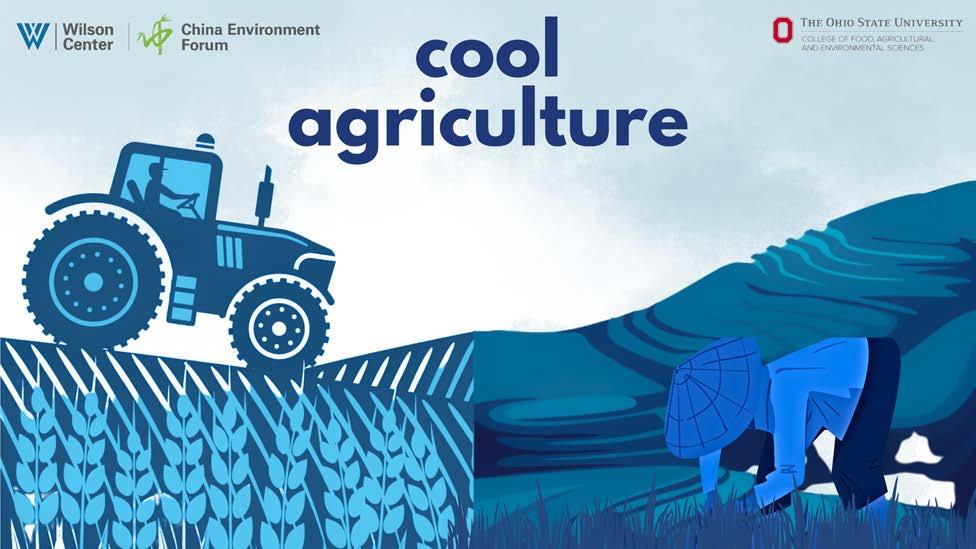
To see more Insights & Analysis, Webinars, and Podcasts, Scan Here


2024,
for
One Woodrow Wilson Plaza 1300 Pennsylvania Avenue, N.W. Washington, DC 20004-3027 China Environment Forum
@cefatwilson @WilsonCEF 202.691.4000
©
Woodrow Wilson International Center
Scholars
www.wilsoncenter.org/program/china-environment-forum cef@wilsoncenter.org facebook.com/chinaenvironmentforum





































